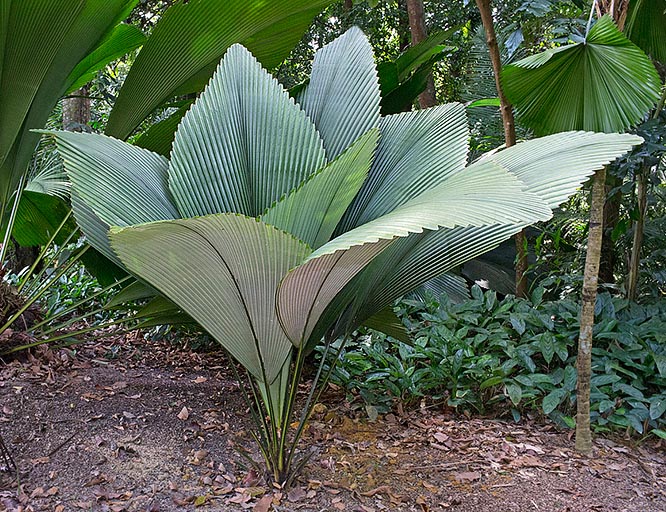Family : Arecaceae

Text © Pietro Puccio

English translation by Mario Beltramini

Johannesteijsmannia magnifica has underground stem and leaves seem to get out from the soil © Giuseppe Mazza
The genus is honoured to the Dutch botanist Johannes Elias Teijsmann (1808-1882); the name of the species is the Latin adjective “magnificus, a, um” = magnificent, splendid, with obvious reference.
Common names: silver joey (English); daun payung (Malaysian); palmeira-magnífica (Portuguese-Brazil).
Johannesteijsmannia magnifica J. Dransf. (1972) is a monoecious species with single underground, prostrate stem, up to about 15 cm of diameter, with the leaves which seem to emerge from the soil. The leaves, on a 1-2 m long petiole, are rhomboid, simple, undivided, coriaceous, plicate, erect, slightly arcuate, up to 3 m long and 2 m broad, toothed at the apex, of intense green colour above, silvery white below; the petioles have two yellowish bands on the sides and toothed margins. The inflorescences, ramified up to the fifth or sixth order, come out between the leaves on a curved tomentose, 50-80 cm long peduncle, almost hidden by the residues of the decayed leaves, enclosed during the initial phase of the growth in 5-6 bract covered by white tomentum; the flowers are hermaphroditic, cream white and intensely perfumed. The fruits are globous, up to 4 cm of diameter, bi- or tri-lobed at times, when they develop from two or three carpels, of brown orange colour, covered by pyramidal tubercules.
It reproduces by seed, previously kept in water for two days, in aerated and draining loam maintained humid at the temperature of 26-28 °C, which germinates in 2-4 months if fresh; the first leaflet is simple, plicate, slightly toothed at the apex. Quite aptly named species, it is by far considered among the most ornamental plants, slow-growing, requires a tropical or subtropical climate, where it can resist to exceptional and extremely short-lasting drops of temperature of some degrees under the +10 °C. It needs high temperatures and ambient humidity, a semi-shaded to shaded position and sheltered from the winds, which would cause damage to the big leaves, and soils rich of organic substance, acidic or neutral, constantly humid, but perfectly draining.
Young specimens are of great ornamental effect when cultivated in pot for the decoration of greenhouses, winter gardens and wide interiors, even if little luminous, using substrata rich of organic substance with addition of coarse siliceous sand or agri-perlite, around the 30%, to improve the drainage, maintained constantly humid, and with temperatures not under the +16 °C. The leaves are utilized by the local populations as roof for huts and makeshift shelters.
→ For general notions about ARECACEAE please click here.
